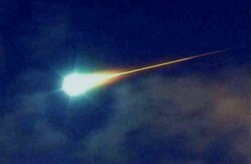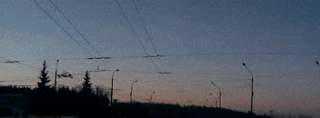Related Research Articles

The Leonids are a prolific annual meteor shower associated with the comet Tempel–Tuttle, and are also known for their spectacular meteor storms that occur about every 33 years. The Leonids get their name from the location of their radiant in the constellation Leo: the meteors appear to radiate from that point in the sky. Their proper Greek name should be Leontids with an additional ⟨t⟩, but the word was initially constructed as a Greek/Latin hybrid and it has been used since.

A meteor, known colloquially as a shooting star, is a glowing streak of a small body going through Earth's atmosphere, after being heated to incandescence by collisions with air molecules in the upper atmosphere, creating a streak of light via its rapid motion and sometimes also by shedding glowing material in its wake. Although a meteor may seem to be a few thousand feet from the Earth, meteors typically occur in the mesosphere at altitudes from 76 to 100 km. The root word meteor comes from the Greek meteōros, meaning "high in the air".

A meteoroid is a small rocky or metallic body in outer space. Meteoroids are distinguished as objects significantly smaller than asteroids, ranging in size from grains to objects up to a meter wide. Objects smaller than meteoroids are classified as micrometeoroids or space dust. Many are fragments from comets or asteroids, whereas others are collision impact debris ejected from bodies such as the Moon or Mars.

A meteor shower is a celestial event in which a number of meteors are observed to radiate, or originate, from one point in the night sky. These meteors are caused by streams of cosmic debris called meteoroids entering Earth's atmosphere at extremely high speeds on parallel trajectories. Most meteors are smaller than a grain of sand, so almost all of them disintegrate and never hit the Earth's surface. Very intense or unusual meteor showers are known as meteor outbursts and meteor storms, which produce at least 1,000 meteors an hour, most notably from the Leonids. The Meteor Data Centre lists over 900 suspected meteor showers of which about 100 are well established. Several organizations point to viewing opportunities on the Internet. NASA maintains a daily map of active meteor showers.

The Perseids are a prolific meteor shower associated with the comet Swift–Tuttle that are usually visible from mid-July to late-August. The meteors are called the Perseids because they appear from the general direction of the constellation Perseus and in more modern times have a radiant bordering on Cassiopeia and Camelopardalis.

A bolide is normally taken to mean an exceptionally bright meteor, but the term is subject to more than one definition, according to context. It may refer to any large crater-forming body, or to one that explodes in the atmosphere. It can be a synonym for a fireball, sometimes specific to those with an apparent magnitude of −4 or brighter.

The Kecksburg UFO incident occurred on December 9, 1965, at Kecksburg, Pennsylvania, United States, when a fireball was reported by citizens of six U.S. states and Canada over Detroit, Michigan, and Windsor, Ontario. Astronomers said it was likely to have been a meteor bolide burning up in the atmosphere and descending at a steep angle. NASA released a statement in 2005 reporting that experts had examined fragments from the area and determined they were from a Soviet satellite, but that records of their findings were lost in 1987. NASA responded to court orders and Freedom of Information Act requests to search for the records. The incident gained wide notoriety in popular culture and ufology, with speculation ranging from extraterrestrial craft to debris from the Soviet space probe Kosmos 96, and is often called "Pennsylvania's Roswell".
The Taurids are an annual meteor shower, associated with the comet Encke. The Taurids are actually two separate showers, with a Southern and a Northern component. The Southern Taurids originated from Comet Encke, while the Northern Taurids originated from the asteroid 2004 TG10, possibly a large fragment of Encke due to its similar orbital parameters. They are named after their radiant point in the constellation Taurus, where they are seen to come from in the sky. Because of their occurrence in late October and early November, they are also called Halloween fireballs. Since 2P/Encke is such a short period comet, the meteors have the slowest impact speed of the annual well-known meteor showers.
The Great Daylight Fireball was an Earth-grazing fireball that passed within 57 kilometres of Earth's surface at 20:29 UTC on August 10, 1972. It entered Earth's atmosphere at a speed of 15 kilometres per second (9.3 mi/s) in daylight over Utah, United States and passed northwards leaving the atmosphere over Alberta, Canada. It was seen by many people and recorded on film and by space-borne sensors. An eyewitness to the event, located in Missoula, Montana, saw the object pass directly overhead and heard a double sonic boom. The smoke trail lingered in the atmosphere for several minutes.

A meteor air burst is a type of air burst in which a meteoroid explodes after entering a planetary body's atmosphere. This fate leads them to be called fireballs or bolides, with the brightest air bursts known as superbolides. Such meteoroids were originally asteroids and comets of a few to several tens of meters in diameter. This separates them from the much smaller and far more common "shooting stars", that usually burn up quickly upon atmospheric entry.

A meteor procession occurs when an Earth-grazing meteor breaks apart, and the fragments travel across the sky in the same path. According to physicist Donald Olson, only four occurrences are known:

An Earth-grazing fireball is a fireball, a very bright meteor that enters Earth’s atmosphere and leaves again. Some fragments may impact Earth as meteorites, if the meteor starts to break up or explodes in mid-air. These phenomena are then called Earth-grazing meteor processions and bolides. Famous examples of Earth-grazers are the 1972 Great Daylight Fireball and the Meteor Procession of July 20, 1860.

The Alpha Monocerotids is a meteor shower active from 15 to 25 November, with its peak occurring on 21 or 22 November. The speed of its meteors is 65 km/s, which is close to the maximum possible speed for meteors of about 73 km/s. Normally it has a low Zenithal Hourly Rate (ZHR), but occasionally it produces much more intense meteor storms that last less than an hour: such outbursts were observed in 1925, 1935, 1985, and 1995. The 1925 and 1935 storms both reached levels passing 1,000 ZHR.

The Chelyabinsk meteor was a superbolide that entered Earth's atmosphere over the southern Ural region in Russia on 15 February 2013 at about 09:20 YEKT. It was caused by an approximately 18 m (60 ft) diameter, 9,100-tonne (10,000-short-ton) near-Earth asteroid that entered the atmosphere at a shallow 18‐degree angle with a speed relative to Earth of 19 kilometres per second. The light from the meteor was briefly brighter than the Sun, visible as far as 100 km (60 mi) away. It was observed in a wide area of the region and in neighbouring republics. Some eyewitnesses also reported feeling intense heat from the fireball.

On 13 October 1990, meteoroid EN131090, with an estimated mass of 44 kg, entered the Earth's atmosphere above Czechoslovakia and Poland and, after a few seconds, returned to space. Observations of such events are quite rare; this was the second recorded using scientific astronomical instruments and the first recorded from two distant positions, which enabled the calculation of several of its orbital characteristics. The encounter with Earth significantly changed its orbit and, to a smaller extent, some of its physical properties.

On September 7, 2015, at about 08:40 local time a bolide meteor appeared over Thailand and burned up approximately 100 km (62 mi) above the ground. The meteor briefly flared up producing a green and orange glow before disappearing without a sound of explosion and leaving a white smoke trail. The meteor was recorded by several dashcams during the morning rush hour in Bangkok, and sightings were also reported in Thai towns of Kanchanaburi and Nakhon Ratchasima. The meteor was visible for about four seconds before fading out. As of September 8, 2015 no strewn field has been found. The impact energy was the largest of 2015 at 3.9 kiloton. The last impact this large was on 23 August 2014 over the Southern Ocean.

2018 LA, also known as ZLAF9B2, was a small Apollo near-Earth asteroid 2.6–3.8 m (9–12 ft) in mean diameter that impacted the atmosphere with small fragments reaching the Earth at roughly 16:44 UTC on 2 June 2018 near the border of Botswana and South Africa. It had been discovered only 8 hours earlier by the Mount Lemmon Survey, Arizona and based on 1+1⁄2 hours of observations, was calculated to have a roughly 85% chance of impact likely somewhere between Australia and Madagascar.
References
- ↑ "'Meteors' sighted in skies across UK". BBC News. 22 September 2012. Archived from the original on 23 September 2012.
- ↑ "'Meteor' sightings across Scotland prompt 999 calls". BBC News. 22 September 2012. Archived from the original on 22 September 2012.
- ↑ "Meteor 'Fireball' Lights Up Sky Across UK". Sky News. 22 September 2012. Archived from the original on 25 September 2012.
- ↑ "Meteor mania: Watch VIDEO of huge comet spotted over north west England". The Mirror. 22 September 2012. Archived from the original on 22 September 2012.
- ↑ "Fireball in sky above Sheffield believed to be 'space junk'". The Star. 27 September 2012. Archived from the original on 14 October 2012.
- ↑ "'Meteor shower' over Northern Ireland 'space junk'". BBC News. 22 September 2012. Archived from the original on 23 September 2012.
- ↑ "More on the 21 September 2012 fireball: why it definitely was a meteor". 24 September 2012. Archived from the original on 27 September 2012.
- ↑ "Fireball over N-Europe on 21 September 2012, 21:45 GMT was likely NOT a reentry". 22 September 2012. Archived from the original on 25 September 2012.
- ↑ Esko Lyytinen (28 September 2012). "Breaking News - UK Earth-hugging Asteroid Circled the Earth and Hit Again". LunarMeteorite Hunter. Archived from the original on 12 May 2013.
12. Phil Williams (January 2015) "The Meteoric Earth-Grazing Fireball of September 2012" Liverpool Astronomical Society Monthly Newsletter (January 2015, pp. 5–9)